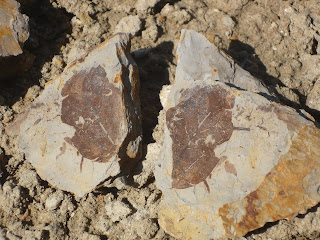Part 2: It's not just for Petsmart Anymore
It's hot in the Big Horn Basin. And the sun is relentless. There is no shade. These conditions are, in large part, what makes this a good place to find fossils. They’re also why Dr. Scott Wing wears huge wrap-around sunglasses fit for someone leaving cataract surgery. One summer a few years ago, a couple of his post-doc students secretly decorated them with crazy glue and gold glitter. This might be a you-have-to-see-it-thing to understand, but they’re pretty sweet sunglasses.
Scott Wing is a paleobotanist. He goes to Wyoming every summer to crack rocks and look for evidence of past plant life. He's spent 37 summers doing this, and says he'll stop only when he can't do it anymore. Dr. Wing isn't just a paleontologist, he's a rock star. Literally. Not only is he a premium scientist for the Smithsonian who has contributed greatly to the study of paleontological flora, he's a talented communicator. He has a gift for explaining the complex in accessible terms. He's one of our go-to people for the scientific nitty gritty. Any exhibition is a balancing act between, on one hand, really detailed, interesting things that people have written books about, and on the other, the visitor's attention span, available time, and interest level. So, someone who can sum up like Dr. Wing is very helpful.
These days, one of Dr. Wing's primary areas of study is a global warming event that happened 55.8 million years ago. Dinosaurs were gone, mammals were just getting started and suddenly a huge amount of carbon dioxide was released into the earth's atmosphere causing the earth's temperature to rise about 5 degrees Celsius. This event took place at the end of the beginning of the Eocene Epoch just after the Paleocene had ended. It is called the Paleocene Eocene Thermal Maximum. It lasted for about 100,000 years.
Scientists debate what caused the release of CO2, with most theories settling on a combination of volcanic activity, a comet impact, a ginormous fire that burned a lot of peat.
There are obvious parallels between the PETM (as it is known) and what's going on today with Global Climate Change. The PETM was a much slower event than the rise in temperatures we're experiencing now, yet the change to the earth's flora was dramatic. Plants that are now found on the Atlantic coast of South Carolina thrived in the Big Horn Basin. Dr. Wing and his work will be highlighted in our exhibition, including a video of him explaining the PETM. Which brings us back to the Big Horn Basin, and me, downing gatorade.
On this particular day, we met at the small tent city Dr. Wing and his cohorts call home and drove (four wheel drive required) to Dr. Wing's dig site for the day. He then began excavating a pit they’d dug into a hillside, and students started cracking rocks with pick-hammers. The spot where a leaf once fell creates a weak plane in the rock, even 55.8 million years later. So a trained eye and a swift tap on the right fissure can reveal a leaf fossil – usually two fossils, one from each side of the leaf.
During a slow few moments, I started playing around with the discard pile. It wasn’t long before I found a small leaf impression. Really! Me, all by myself, with rocks from the discard pile! I showed it to Dr. Wing, just in case it was important, and wouldn’t you know it, it was! He said it was the best fossil found all day so far, whatever that’s worth. Here’s a photo of my leaf fossil, now in a box somewhere in the Smithsonian’s collection.

He did let me take home a couple other less impressive leaf impressions, though. Apparently, this is common. Paleontologists call them “party fossils.”
If you’d like to learn more about the PETM, you can wait until May of 2010 and come to the Washakie Museum in Worland, WY. Or you can watch this American Museum of Natural History video featuring Dr. Wing (and several other of our Guest Curators). Or you can just google it – it’s pretty interesting and fairly depressing.
Oh, and if you ever forget the initials PETM – just think about Petsmart. PETM is that store’s NYSE ticker abbreviation.
Scott Wing is a paleobotanist. He goes to Wyoming every summer to crack rocks and look for evidence of past plant life. He's spent 37 summers doing this, and says he'll stop only when he can't do it anymore. Dr. Wing isn't just a paleontologist, he's a rock star. Literally. Not only is he a premium scientist for the Smithsonian who has contributed greatly to the study of paleontological flora, he's a talented communicator. He has a gift for explaining the complex in accessible terms. He's one of our go-to people for the scientific nitty gritty. Any exhibition is a balancing act between, on one hand, really detailed, interesting things that people have written books about, and on the other, the visitor's attention span, available time, and interest level. So, someone who can sum up like Dr. Wing is very helpful.
These days, one of Dr. Wing's primary areas of study is a global warming event that happened 55.8 million years ago. Dinosaurs were gone, mammals were just getting started and suddenly a huge amount of carbon dioxide was released into the earth's atmosphere causing the earth's temperature to rise about 5 degrees Celsius. This event took place at the end of the beginning of the Eocene Epoch just after the Paleocene had ended. It is called the Paleocene Eocene Thermal Maximum. It lasted for about 100,000 years.
Scientists debate what caused the release of CO2, with most theories settling on a combination of volcanic activity, a comet impact, a ginormous fire that burned a lot of peat.
There are obvious parallels between the PETM (as it is known) and what's going on today with Global Climate Change. The PETM was a much slower event than the rise in temperatures we're experiencing now, yet the change to the earth's flora was dramatic. Plants that are now found on the Atlantic coast of South Carolina thrived in the Big Horn Basin. Dr. Wing and his work will be highlighted in our exhibition, including a video of him explaining the PETM. Which brings us back to the Big Horn Basin, and me, downing gatorade.
On this particular day, we met at the small tent city Dr. Wing and his cohorts call home and drove (four wheel drive required) to Dr. Wing's dig site for the day. He then began excavating a pit they’d dug into a hillside, and students started cracking rocks with pick-hammers. The spot where a leaf once fell creates a weak plane in the rock, even 55.8 million years later. So a trained eye and a swift tap on the right fissure can reveal a leaf fossil – usually two fossils, one from each side of the leaf.
During a slow few moments, I started playing around with the discard pile. It wasn’t long before I found a small leaf impression. Really! Me, all by myself, with rocks from the discard pile! I showed it to Dr. Wing, just in case it was important, and wouldn’t you know it, it was! He said it was the best fossil found all day so far, whatever that’s worth. Here’s a photo of my leaf fossil, now in a box somewhere in the Smithsonian’s collection.

He did let me take home a couple other less impressive leaf impressions, though. Apparently, this is common. Paleontologists call them “party fossils.”
If you’d like to learn more about the PETM, you can wait until May of 2010 and come to the Washakie Museum in Worland, WY. Or you can watch this American Museum of Natural History video featuring Dr. Wing (and several other of our Guest Curators). Or you can just google it – it’s pretty interesting and fairly depressing.
Oh, and if you ever forget the initials PETM – just think about Petsmart. PETM is that store’s NYSE ticker abbreviation.


Comments
(i love the new sidebar quotes from the girls) :)